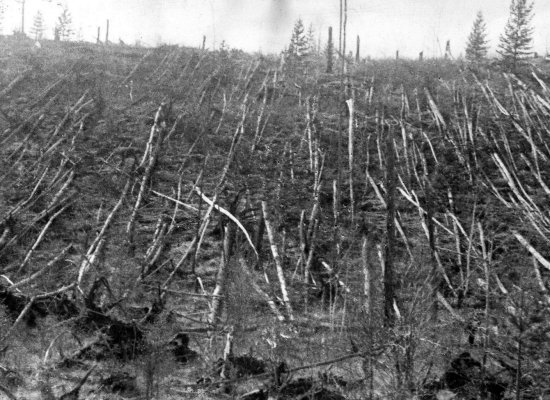

Posted on 05/07/2009 8:47:49 AM PDT by JoeProBono
On the morning of June 30, 1908, the sky exploded over a remote region of central Siberia. A fireball powerful as hundreds of Hiroshima atomic blasts scorched through the upper atmosphere "as if there was a second sun," according to one eyewitness.
Scientists today think a small fragment of a comet or asteroid caused the "Tunguska event," so named for the Tunguska river nearby. No one knows for certain, however, because no fragment of the meteoroid has ever been found. The explosion was so vast—flattening and incinerating over an 800 square-mile swath of trees—that generations of amateur sleuths have put forward scenarios as strange as stray black holes or UFO attacks to explain the tremendous explosion.
Now, a controversial new scientific study suggests that a chunk of a comet caused the 5-10 megaton fireball—what amounts to the largest non-nuclear explosion in modern history. Crucially, according to the new hypothesis, most of the comet bounced off the atmosphere and back into orbit around the sun.
The scientists have even identified a candidate Tunguska object—now more than 100 million miles away—that was somewhere near Earth on June 30, 1908 and will be passing close to Earth again in 2045. But just how could a comet—basically a ball of water ice and cosmic dust—create such a massive explosion and leave no trace? The answer, the scientists believe, can be found in basic chemistry rather than complicated physics or hidden evidence.
One of the most peculiar leftovers from the Tunguska event is the pattern of scorched earth it left behind. No mere circular blast, Tunguska’s trail of charred trees fan out like a butterfly, with outer "wings" that spread both in a north-northeast direction and a south-southeast direction.
Top scientists, such as Giuseppe Longo of the University of Bologna in Italy and Yuri Medvedev of the Russian Institute of Applied Astronomy, presented with this unusual pattern, have circled around two main theories—that either two separate objects exploded in the skies over the region or one object skipped over the atmosphere, circled the earth and then re-entered over the Tunguska region on its second pass.
Edward Drobyshevski, a research physicist at the Russian Academy of Sciences in St. Petersburg, thinks that instead, Tunguska is such a mystery because the comet fragment packed its own explosives—in the form of hydrogen, the gas that turned the Hindenburg airship into a blazing inferno in seconds......


.
Aster risk
because the comet fragment packed its own explosives—in the form of hydrogen
bttt

Beautiful but scary pic.
The hydrogen is unlikely to have much effect. The kinetic energy of just about any interplanetary impact will be much greater than the chemical energy available from the impactor. A quick lookup showed that at 3 km/s closing velocity the kinetic energy of an object is the same as the chemical energy of the same mass of TNT - and 3 km/s is pretty slow when dealing with orbital velocities.


“A fireball powerful as hundreds of Hiroshima atomic blasts scorched through the upper atmosphere...”
OK... This was in 1908. How come the rest of the planet didn’t suffer? Why didn’t we as a species go extinct? Why weren’t our skies darkened for months, killing the ozone layer and bringing on global warming?
Yet, this is the type of scenario they teach us is what killed off the dinosaurs...
Comets mainly seem to be dirty snowballs. Consider a big ( say a hundred yards diameter) snowball entering the atmosphere at over 7 miles/sec straight down. It is in significant atmosphere for only about the last 10 seconds. It’s energy gets expended in vaporizing itself.
maybe the one in the Yucitan was the size of...Yucitan?
Dinosaur killer? The Nat’l Geographic, History & Discovery channel documentaries keep telling me that the Yucatan meteor was about the size of Manhattan island scooped up into a ball.
 |
||
| · join · view topics · view or post blog · bookmark · post new topic · | ||

The first expedition began in 1921 and, for over a decade, other followed. Kulik heard and registered the accounts of the region's inhabitants. They mentioned seeing a bright blue trail crossing the sky, a very bright flash, the roar of a thunder and the shock waves that pounded the ground and shattered the glass. For the several nights that followed the sky was bright and sparkled. The accounts, however, varied from one person to another, when it came to the sequence and duration of the events.


Kulik also tried to fix the limits of the area of the event, through the destruction of about 80 million trees in a radius of 50 km from a central point where the force seemed to come from. An aerial observation revealed that it actually had the shape of a butterfly with an area of 215 000 acres completely destroyed. However, not a single sign of a crater was found.
The size of he Tungusku boloid was probably about 40 meters in diameter. The size of the Yucatan boloid was probably about 10 kilometers. “Since the 1908 comet was probably traveling in a direction opposite to that of earth...would give a speed of 60 kilometers per second.” The explosion had about the force of 700 Hiroshima bombs. “Vast amounts of fire debris arrived in California some two weeks later, noticeably depressing the transparency of the atmosphere over the Golden State.” In 1978 a Czech astronomer noted that comet Encke had changed its orbit in 1908 which could have been induced by losing a Tunguska object sized fragment. Microtectite spherules found at the Tunguska site have an iridium concentration as high as 56,900 parts per billion which is similar in content to an iron meteorite. SOURCE: The Great Dying, by Kenneth J. Hsu, 1986.
I highly recommend this book to anyone interested in extraterrestrial extinction events even though it was written just before the discovery of the 100 mile wide Yucatan crater site. The book covers the early development of earth sciences, and the dispute between uniformitarians and catastrophists. It does a very good job of showing the checks and balances of the scientific process which finally promoted the search for the missing crater. This discovery was a big boon for modern catastrophists.
I hope it is clear that the reason we did not go extinct is that there is a big difference between the blow from a 125 foot object, and one 7 miles in diameter.
Facinating - thanks.
Thanks g.
Disclaimer: Opinions posted on Free Republic are those of the individual posters and do not necessarily represent the opinion of Free Republic or its management. All materials posted herein are protected by copyright law and the exemption for fair use of copyrighted works.